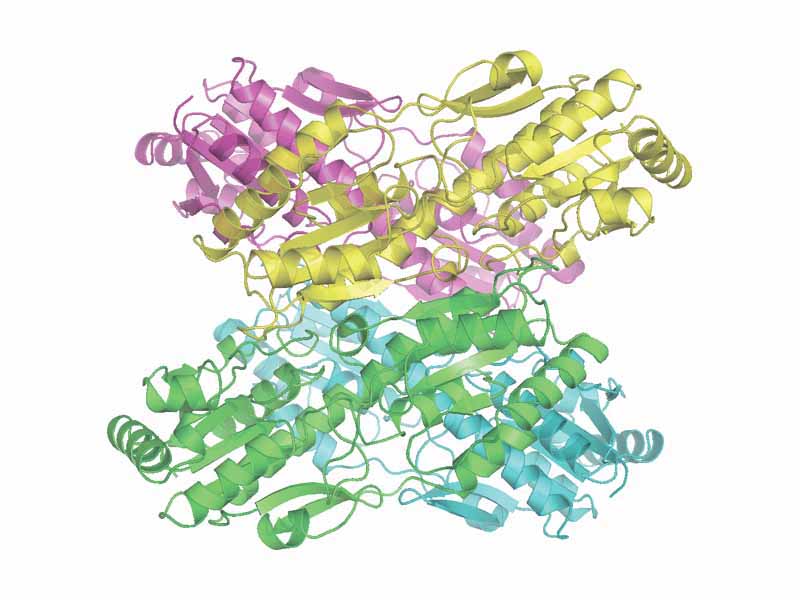Interdisciplinary Note (22 of 22)
Nonpolar molecules attract each other through Van der Waals (London dispersion) forces. It is a common misconception to think that the hydrophobic interactions often discussed in the biochemical context are synonymous with that type of intermolecular force. Nonpolar molecules attract one another with Van der Waals force. Nonpolar biomolecules in the cytosol aggregate through hydrophobic interactions. For example, hydrophobic interactions are a major factor stabilizing quaternary structure in proteins. It's easy to come away thinking that London dispersion forces and hydrophobic interactions are the same thing. What's going on with hydrophobic interactions, however, is a lot more complicated and a lot stronger than Van der Waals force. Van der Waals forces do play a role in holding the subunits together, but what is really holding them together is water's attraction for itself and the disorder water has in the bulk phase.
Imagine that in a µmol our protein, the subunits separated so that their hydrophobic domains were now facing the water. Leucine, phenylalanine, valine and other hydrophobic side chains are now jutting out into the water. Separation not only involves overcoming the Van der Waals forces between the subunits, water molecules have to be forced apart from each other to make room for the side chains which are now in their midst jutting out into the water. Hydrogen bonds between water molecules have to have been separated at the interfaces with the nonpolar side chains, a kind of microscopic surface tension. This is an electrostatic potential energy increase. It's almost a tenth of dissociation energy of a typical covalent bond to completely separate a hydrogen bond in water, so it is very significant. From a thermodynamic perspective, this would represent an internal energy increase for the system for the subunits to separate. In thermochemistry, we will talk about how this would be an enthalpy increase (it would be endothermic).
Additionally, if water is forced to be next to a big nonpolar group, the water molecules will orient towards each other. They're not going to point their dipoles in towards the hydrophobic group, but towards each other, forming a kind of ordered cage around the hydrophobic group. This is known as "entropic penalty". In other words, the nonpolar group forces the water to become more orderly. Its entropy decreases.
Imagine you did that to a µmol of subunits. You reached in and rotated them apart. But then you let them go, the hydrophobic domains would start finding their way back together. The water molecules will increase their hydrogen bonding, no longer having the nonpolar group keeping them apart. Internal energy will decrease. Enthalpy will decrease. In other words, letting them go to fall back together will be exothermic. This heat flow into the surroundings will increase the entropy of the surroundings (the more things jiggle around the more disordered they are). Also, the water part of our system will become more disordered because it doesn't have to make that ordered cage around the hydrophobic residues any more. That increases the entropy of the system. In summary, the system is becoming more disordered plus heat is flowing into the surroundings making them more disordered. The system plus the surroundings is the universe. The entropy of the universe must be increasing. It can't turn back. The second law of thermodynamics tell us that what's happening is spontaneous. This is another way of saying it represents a free energy decrease for the system (peptides plus the water) for the two hydrophobic domains to come together. The hydrophobic domains retreat from the water into self-aggregation, but it's not so much that the domains are hydrophobic but that the water is nonpolar-group-phobic. It's the water driving things. Water's strong impetus to self-associate is always pushing nonpolar domains of biological macromolecules into separate phase spaces. This is a primary factor determining the structural dynamics of protein folding, as hydrophobic residues retreat to the interior of globular proteins and at the quaternary structure level as hydrophobic domains of separate polypeptides come together. The same process is behind the self-aggregation of membrane lipids. Hydrophobic interactions drive phosopholipids to form the bilayer as well as the hydrophobic, membrane-spanning α-helices of integral membrane proteins that embed themselves into the membrane. We call this type of thing "hydrophobic interaction", but that doesn't quite do it justice.
We did our best to write in a straight-forward, clear way, but for almost everyone preparing for the MCAT, even those on their way to 525 on this exam, at this stage of MCAT review, there may have been some struggle in making sense of everything you just read. Struggle! This is a spiraling curriculum. We are priming a way of talking about things and introducing important ideas that come later. You have to show your brain what it's going to be wrestling with. This is a scouting expedition. These are difficult concepts, but they are crucial.
